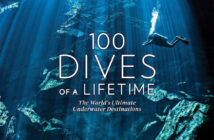With all the dive adventures available around the world, it’s hard to pin down one as the “ultimate dive”. Each offers something unique and fascinating. However, there is one that stands out above the rest with an unrivaled experience that can only be described as other worldly – the pelagic black water dive.
I was fortunate enough to be hired for a shoot on the Big Island of Hawai’i (I know, tough job, right?). Not willing to pass up the opportunity, I booked my travel home a week after the shoot was scheduled to wrap. The pelagic black water dive sat as number one on my list of things to do. In fact, it was number one on my “list” since reading an article about it nearly a year ago. There are a handful of dive operators in Kona who run black water charters, each on select nights of the week. I went out on a Monday and a Wednesday, which required booking through two different shops (Big Island Divers and Neptune Charlie’s Ocean Safaris). Both experiences were top notch. Be sure to book early as most shops are limited to six divers and spots fill fast. Every shop has their own set of prerequisites to book your dive. At minimum, you’ll need 25 logged dives with one dive in the past six months and at least two night dives. Some shops require you have a night dive with them before the pelagic black water dive. This is easily accomplished by either booking a night reef dive, or a combo manta ray/black water dive.

Many species encountered on a pelagic black water dive are transparent, like this Salpa maxima. This feature provides excellent camouflage in the open ocean and is the primary defense against predation
Taking place at night (hence black water) in the open ocean (the pelagic zone), the pelagic black water dive is not for the faint of heart. Divers are ferried off shore well after sunset to depths ranging from 1,000-6,000 feet (300-1800 meters). If the moon is not out, this can be an eerie ride. The black sky fades into the black seas ahead. Behind, lights on shore shrink into the distance. Exactly how far off shore you must go depends on where in the world you are. The Kona Coast of Hawai’i is well known for amazing pelagic black water dives. Here you need only travel a couple of miles from the harbor to find yourself with 6,000 feet of water below.

Eurhamphaea vexilligera, better known as a Comb Jelly, propels itself through the water with eight rows of cilia – seen here producing various colors of bioluminescent light. With its “mouth” open wide the Comb Jelly feeds on just about anything small enough to capture
Ironically, this dive does not require a deep diving submersible or even the skills and experience of a tech diver. At night, creatures of all types gather near the surface to feed. Phytoplankton – the photosynthesizing, microscopic organisms that only live near the sun soaked surface of the ocean – attract zooplankton – larger, ocean drifting organisms that include krill, larvae of all types, and invertebrates such as jelly fish. The zooplankton often attract small fish and squid, which occasionally attract larger predators such as dolphins, sharks, and whales. Even though the ocean bottom is often more than 1,000 feet deep, the best diving takes place above 30 feet (10 meters).

This Sea Gooseberry, Euplokamis dunlapae, extends two tentacles in an attempt to capture smaller zooplankton.
Upon arriving at the dive site, the crew will attach several ropes to the boat. Actual length varies depending on the dive operation, but they’re usually somewhere between 30 and 60 feet (9 to 18 meters) long with a weight at the end. This rope literally becomes your life line. A shorter tether line connects you to the drop line, securing you to the boat, while also allowing free movement through the water column. Descending on this line for the very first time can be a little nerve racking. The pitch-black water goes on endlessly in every direction. You feel as though you are diving in nothing.
Even though it is not uncommon to have nearly 100 feet (30 meters) of visibility on a pelagic black water dive, the experience is more closely related to muck diving. There is no bottom or structure of any kind to reference for depth or orientation. The plankton soup drifting by is reminiscent of suspended sediment so common to rock quarries and surf zones. In fact, as a Midwestern rock quarry diver, I felt right at home. The major difference is the particulate in the water is not muck, but rather living creatures!

This Forskalia edwardsi looks more intergalactic than it does oceanic. When threatened, the tentacles contract and the Siphonophore shoots off, spinning on its central axis like some alien spaceship.
Very little is recognizable for the first timer. There are pyrosomes, siphonophores, tunicates, ctenophores, crustacean and fish larvae, and much more. The discovery of so many new creatures makes it easy to lose track of your depth and orientation. There are a few things every new pelagic black water diver should be prepared for.

Bioluminescence comes in two forms – chemical and reflective. These amazing light shows are used to attract food or warn off predators.
A lack of reference – With no bottom or structure to reference, it can become difficult to know how deep you are or even which way is up. Keep your depth gauge handy and pay close attention to your ears. Also, remember your bubbles always go up. If you find yourself in a moment of vertigo, first stay calm, orient yourself to your bubbles, then turn around to see your dive buddies. It may take a moment for your brain to adjust before you can go back to the dive. If it doesn’t, don’t be afraid to signal to the divemaster that you need to end the dive. Nearly every pelagic black water dive outing loses a diver or two to vertigo or uneasy feelings about hanging out in the open ocean at night.

The Praya dubia, or giant siphonophore, lives at depths of over 2000 feet (700 meters) deep. Large colonies can stretch to 130 feet (40 meters) in length.
Prepare to get stung – Many of the creatures drifting by sting their prey like jelly fish. While momentarily uncomfortable, most pose no harm or lasting effects. A full exposure suit, gloves, and a hood will minimize possible contact. If you do get stung, stay calm. If the pain is bearable, wait a few moments to see if it passes. I was stung several times on both dives, each time the stinging lasted only a few seconds. Your dive crew will brief you on any potentially harmful jelly fish and how to respond if you think you are stung by one. Commit those instructions to memory and follow them to a T.
Master your buoyancy – There are basically two techniques you can use on a pelagic black water dive. The first involves hanging onto the rope, using it as a guide to move up and down the water column. While completely acceptable, this method will rob you of much of the experience as you are drug through the current and get only a fleeting look at everything that passes by. The second option is to orient yourself into the current and swim ahead to the extent your tether will allow. Certainly, this takes a lot more guts as you leave the comfort of the down line, but the payoff is extraordinary. You now can drift with any interesting finds, providing a few moments to take a closer look and really investigate. Once reaching the end of your tether on the down current side, head back into the current waiting for the next morsel to come by. If you’re goal is to capture photos or video, this is hands down the best approach as it gives you the time to get the shot you’re looking for. For the shutter bugs and videophiles, buoyancy is especially important – more on this in part 2.

This is a Pyrosome, of which the specific species I have yet to identify. What’s really interesting about Pyrosomes is they are made up of hundreds, sometimes thousands, of individuals, known as zooids. Each species always connects in the same manner to form the same shape and accomplish the same tasks.
Mind your light – We are taught while night diving to avoid shining your light in or near another diver’s face. Doing so not only temporarily blinds them, it distracts from their own personal experience. The majority of what you see on a pelagic black water dive reflects very little light, making it that much more imperative that you do not flag a dive buddy with your light. One of the best approaches to handling your light is to hold it below your face pointing it up and out. This reduces the chance of flagging a dive buddy and puts the light beam right where you need it – just a couple of feet in front of you.
Look closely – Except for the occasional mammal or large fish sighting, most creatures on this dive are small, ranging from a fraction of an inch to maybe five or six inches in length. Some species, such as Salp, can form long colonial chains that may stretch so long you cannot see both ends. Designed to live in the open ocean, many species are nearly transparent. This makes it very difficult to spot anything from a distance. Keep your light and your attention close, scanning from six to ten feet out all the way in to the tip of your nose. Your divemaster will alert everyone to the presence of larger fish or mammals, such as dolphins, squid, and the occasional pelagic shark.

A krill hitches a ride aboard a Salpa maxima colony. A risky undertaking considering it could very easily become a meal.
The pelagic black water dive is an experience I think every diver should work towards. There truly is nothing else that compares. If you’re uncertain of hanging off a boat in the open ocean at night, I would encourage you to get some experience in the muck. The feelings invoked and skills required are much the same. Admittedly, this dive is not for everyone, but how can you know without giving it a try? The only negative I found was the fact that it’s only a one tank dive!









